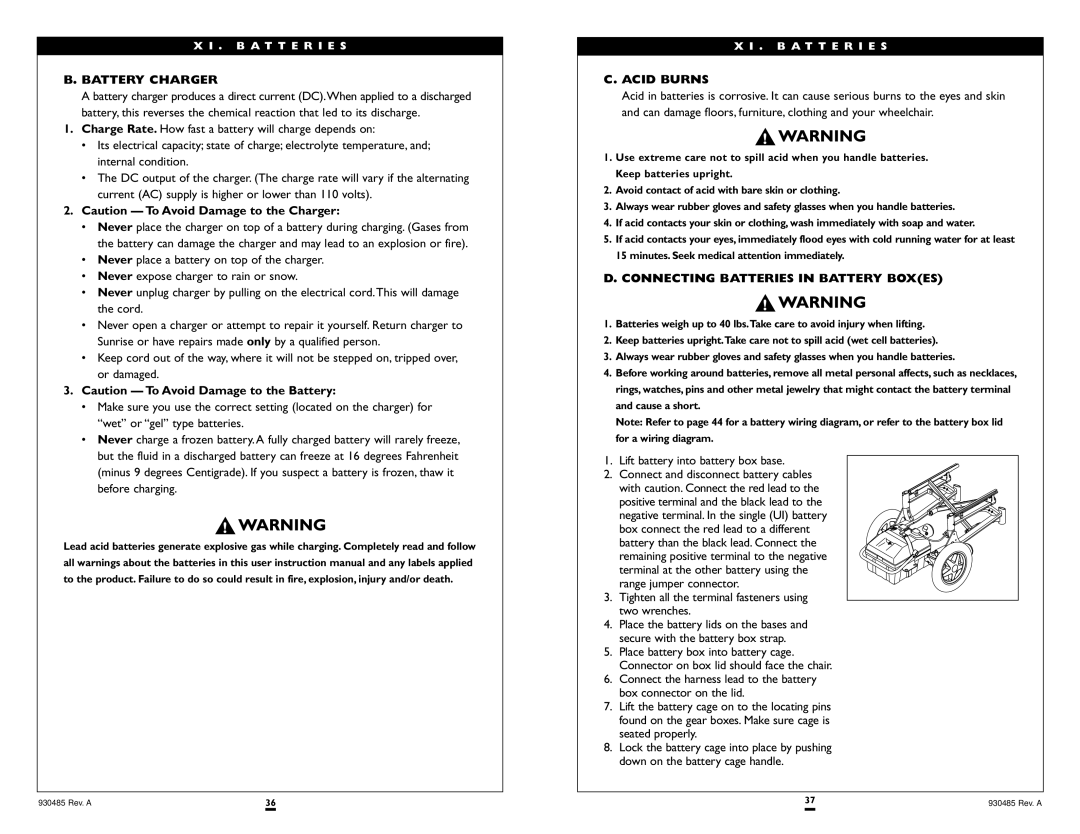
X I . B A T T E R I E S
B. BATTERY CHARGER
A battery charger produces a direct current (DC).When applied to a discharged battery, this reverses the chemical reaction that led to its discharge.
1.Charge Rate. How fast a battery will charge depends on:
•Its electrical capacity; state of charge; electrolyte temperature, and; internal condition.
•The DC output of the charger. (The charge rate will vary if the alternating current (AC) supply is higher or lower than 110 volts).
2.Caution — To Avoid Damage to the Charger:
•Never place the charger on top of a battery during charging. (Gases from the battery can damage the charger and may lead to an explosion or fire).
•Never place a battery on top of the charger.
•Never expose charger to rain or snow.
•Never unplug charger by pulling on the electrical cord.This will damage the cord.
•Never open a charger or attempt to repair it yourself. Return charger to Sunrise or have repairs made only by a qualified person.
•Keep cord out of the way, where it will not be stepped on, tripped over, or damaged.
3.Caution — To Avoid Damage to the Battery:
•Make sure you use the correct setting (located on the charger) for “wet” or “gel” type batteries.
•Never charge a frozen battery. A fully charged battery will rarely freeze, but the fluid in a discharged battery can freeze at 16 degrees Fahrenheit (minus 9 degrees Centigrade). If you suspect a battery is frozen, thaw it before charging.
Lead acid batteries generate explosive gas while charging. Completely read and follow all warnings about the batteries in this user instruction manual and any labels applied to the product. Failure to do so could result in fire, explosion, injury and/or death.
X I . B A T T E R I E S
C. ACID BURNS
Acid in batteries is corrosive. It can cause serious burns to the eyes and skin and can damage floors, furniture, clothing and your wheelchair.
1.Use extreme care not to spill acid when you handle batteries. Keep batteries upright.
2.Avoid contact of acid with bare skin or clothing.
3.Always wear rubber gloves and safety glasses when you handle batteries.
4.If acid contacts your skin or clothing, wash immediately with soap and water.
5.If acid contacts your eyes, immediately flood eyes with cold running water for at least 15 minutes. Seek medical attention immediately.
D. CONNECTING BATTERIES IN BATTERY BOX(ES)
1.Batteries weigh up to 40 lbs.Take care to avoid injury when lifting.
2.Keep batteries upright.Take care not to spill acid (wet cell batteries).
3.Always wear rubber gloves and safety glasses when you handle batteries.
4.Before working around batteries, remove all metal personal affects, such as necklaces, rings, watches, pins and other metal jewelry that might contact the battery terminal and cause a short.
Note: Refer to page 44 for a battery wiring diagram, or refer to the battery box lid for a wiring diagram.
1.Lift battery into battery box base.
2. Connect and disconnect battery cables with caution. Connect the red lead to the positive terminal and the black lead to the negative terminal. In the single (UI) battery box connect the red lead to a different battery than the black lead. Connect the remaining positive terminal to the negative terminal at the other battery using the range jumper connector.
3.Tighten all the terminal fasteners using two wrenches.
4.Place the battery lids on the bases and secure with the battery box strap.
5.Place battery box into battery cage. Connector on box lid should face the chair.
6.Connect the harness lead to the battery box connector on the lid.
7.Lift the battery cage on to the locating pins found on the gear boxes. Make sure cage is seated properly.
8.Lock the battery cage into place by pushing down on the battery cage handle.
930485 Rev. A | 36 | 37 | 930485 Rev. A |
